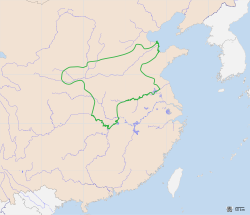
Back Shang-Dynastie ALS مملكة شانغ Arabic শ্বাং ৰাজবংশ Assamese Dinastía Shang AST Şan sülaləsi Azerbaijani شان سولالهسی AZB Шан (династия) Bashkir Dinastiyang Shang BCL Шан (дынастыя) Byelorussian Шан Bulgarian
Shang | |||||||||||
|---|---|---|---|---|---|---|---|---|---|---|---|
| c. 1600 – c. 1046 BC | |||||||||||
 Approximate extent of Shang territory within present-day China | |||||||||||
| Capital | |||||||||||
| Common languages | Old Chinese | ||||||||||
| Religion | Shang state religion | ||||||||||
| Government | Monarchy | ||||||||||
| King | |||||||||||
• c. 1600 BC | Tai Yi | ||||||||||
• c. 1250 – 1191 BC | Wu Ding | ||||||||||
• c. 1075 – 1046 BC | Zhou | ||||||||||
| Historical era | Bronze Age | ||||||||||
• Established | c. 1600 BC | ||||||||||
| c. 1046 BC | |||||||||||
| Area | |||||||||||
| c. 1122 BC[1] | 1,250,000 km2 (480,000 sq mi) | ||||||||||
| Currency |
| ||||||||||
| |||||||||||
| Shang | |||||||||||||||||||||||||||||||||||||||
|---|---|---|---|---|---|---|---|---|---|---|---|---|---|---|---|---|---|---|---|---|---|---|---|---|---|---|---|---|---|---|---|---|---|---|---|---|---|---|---|
 "Shang" in oracle bone script (top left), bronze script (top right), seal script (bottom left), and regular script (bottom right) forms | |||||||||||||||||||||||||||||||||||||||
| Chinese | 商 | ||||||||||||||||||||||||||||||||||||||
| Hanyu Pinyin | Shāng | ||||||||||||||||||||||||||||||||||||||
| |||||||||||||||||||||||||||||||||||||||
| Alternative Chinese name | |||||||||||||||||||||||||||||||||||||||
| Chinese | 殷 | ||||||||||||||||||||||||||||||||||||||
| Hanyu Pinyin | Yīn | ||||||||||||||||||||||||||||||||||||||
| Part of a series on the |
| History of China |
|---|
The Shang dynasty (Chinese: 商朝; pinyin: Shāngcháo), also known as the Yin dynasty (殷代; Yīn dài), was a Chinese royal dynasty that ruled in the Yellow River valley during the second millennium BC, traditionally succeeding the Xia dynasty and followed by the Western Zhou dynasty. The classic account of the Shang comes from texts such as the Book of Documents, Bamboo Annals and Shiji. Modern scholarship dates the dynasty between the 16th and 11th centuries BC, with more agreement surrounding the end date than beginning date.
The Shang dynasty is the earliest dynasty within traditional Chinese history that is firmly supported by archaeological evidence. The archaeological site of Yinxu, near modern-day Anyang, corresponds to the final Shang capital of Yin. Excavations at Yinxu have revealed eleven major royal tombs, the foundations of former palace buildings, and the remains of both animals and humans that were sacrificed in official state rituals.
Tens of thousands of bronze, jade, stone, bone, and ceramic artefacts have been uncovered at Yinxu. Most prominently, the site has yielded the earliest known examples of Chinese writing—a corpus primarily consisting of divination texts inscribed on oracle bones, which were usually either turtle shells or ox scapulae. More than 20,000 oracle bones were discovered during the initial scientific excavations during the 1920s and 1930s, with over four times as many having been found since. The inscriptions provide critical insight into many topics from the politics, economy, and religious practices to the art and medicine of the early stages of Chinese history.[2]
- ^ Turchin, Peter; Adams, Jonathan M.; Hall, Thomas D. (December 2006), "East-West Orientation of Historical Empires and Modern States", Journal of World-Systems Research, 12 (2): 219–229, doi:10.5195/JWSR.2006.369, ISSN 1076-156X
- ^ Keightley (2000).